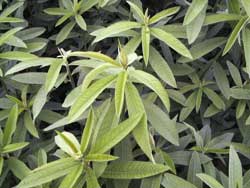Can hemp help the everglades?

Sunn Hemp can be effective in reducing weeds and leaching while enriching soil. Credit: Thomas Potter
Within Southern Florida, soil and water conditions indicate potential for leaching from the use of atrazine-based herbicides in corn crops. Scientists from USDA-Agricultural Research Service (ARS) and University of Florida conducted studies to evaluate the specific groundwater risk from atrazine use by focusing on a specific cover crop that seems to have the potential to greatly reduce that risk. The crop is called sunn hemp. It’s a tall, herbaceous annual that grows rapidly to a height of 6 to 7 feet.
The region’s aquifer provides drinkable water for nearly all of the rapidly growing population. Agricultural practices that impair water quality may also stunt a massive project intended to restore the Florida Everglades ecosystem. Many investigations have shown that cover crops can reduce herbicide leaching; however groundwater quality has not been widely observed and the effectiveness of cover crops on water contamination has not been documented.
The studies revealed that atrazine and some of its products may seep into the groundwater and impair water quality. Climate, cropping patterns, high dilution rates, and high chemical degradation rates limited the contamination levels. Measurements also showed that cover crops significantly reduced contamination in groundwater. The studies focused on sweet corn production and included whether fields with a highly vigorous cover crop would reduce impacts. Sunn hemp planted during uncultivated summer periods was the most focused upon. Crops such as these can be effective in reducing weeds and leaching while enriching soil. Sunn hemp can be grown to prevent soil erosion, as high-protein forage, and in older plants, it can be used to make cloth, twine, and rope.
Results of this four year study, which has support from the South Florida Water Management District, were published in the 2007 September-October issue of the Journal of Environmental Quality. Levels of atrazine and three of its products were monitored in groundwater directly beneath sweet corn plots treated annually with the herbicide. On plots maintained with the cover crop, all plant residues were chopped and turned into soil before planting the next corn crop.
Growers are encouraged to plant cover crops since there are many other potential benefits, including reduced nutrient leaching, wind erosion, and improved soil quality. To promote adoption of the practice, further research is needed to identify more cover crops that behave similar to sunn hemp and the low-cost sources of its seed. High seed cost is a limiting factor to more widespread use of this effective cover crop.
Atrazine is also used globally resulting in numerous studies that demonstrate its contamination of water supplies. Both the original compound and its subsequent products are being detected in surface water and shallow groundwater. This highlights the need to determine the extent of water risks during atrazine use and to develop conservation practices to minimize negative affects.
Media Contact
More Information:
http://www.agronomy.orgAll latest news from the category: Ecology, The Environment and Conservation
This complex theme deals primarily with interactions between organisms and the environmental factors that impact them, but to a greater extent between individual inanimate environmental factors.
innovations-report offers informative reports and articles on topics such as climate protection, landscape conservation, ecological systems, wildlife and nature parks and ecosystem efficiency and balance.
Newest articles

Superradiant atoms could push the boundaries of how precisely time can be measured
Superradiant atoms can help us measure time more precisely than ever. In a new study, researchers from the University of Copenhagen present a new method for measuring the time interval,…

Ion thermoelectric conversion devices for near room temperature
The electrode sheet of the thermoelectric device consists of ionic hydrogel, which is sandwiched between the electrodes to form, and the Prussian blue on the electrode undergoes a redox reaction…

Zap Energy achieves 37-million-degree temperatures in a compact device
New publication reports record electron temperatures for a small-scale, sheared-flow-stabilized Z-pinch fusion device. In the nine decades since humans first produced fusion reactions, only a few fusion technologies have demonstrated…





















